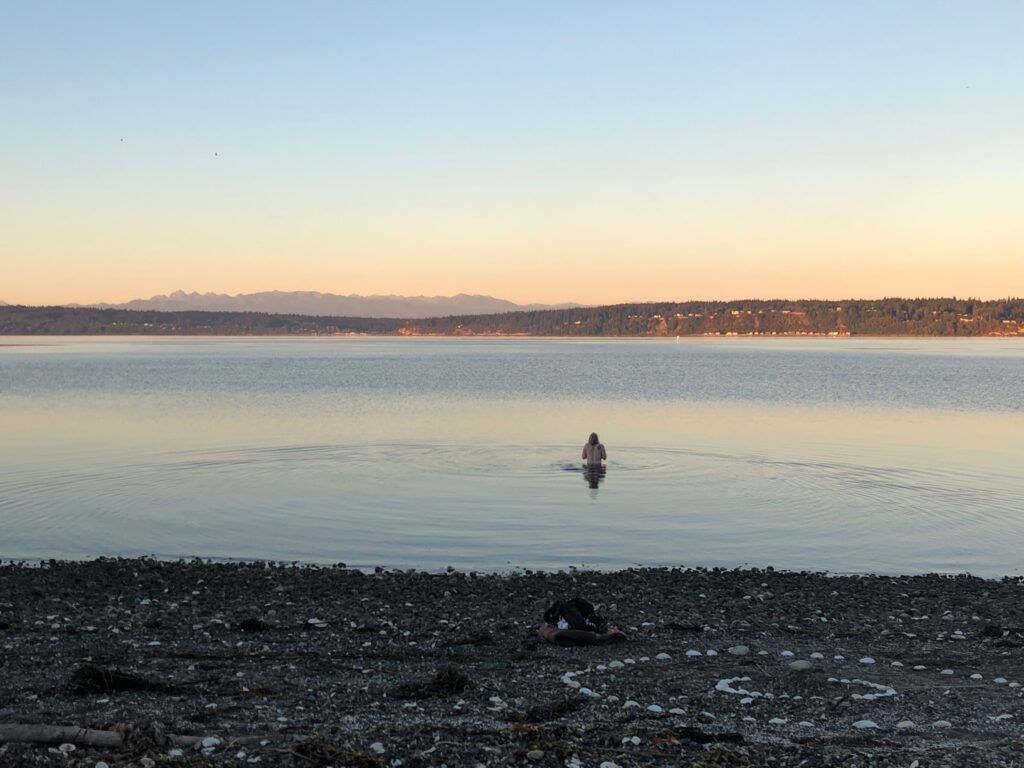The sun was just warming the sky with the first blush of pink and purple; the sounds of daybreak resonated over the threshold of land and sea. We were gathered together for a weekend on the banks of the Salish Sea for a rewilding retreat—a temenos time to reconnect our spiritual practices and sense of the Sacred within the more-than-human world. While I was starting the fire for a beachfront morning matins, I heard the song—sonorous notes rippling over the waves coming from a lone kayak put out to sea. It was sung as an offering to a sacred and animate world. And then, the bobbing heads of seals emerged through the waves, encircling the modern coracle, receiving the morning melody that called to them and affirming the enchantment of the moment.
Modernity has created a chasm that separates humanity from humus, earth’s terra firma, primary essence. This rift grows ever wider as ancient stories and ways of worship that connect people to place are no longer told and practiced, and are, even worse, forgotten. Ecocide, the willful destruction of the environment, is the result of this cultural amnesia, a forgetting of where we are and why that matters. Without a felt sense of belonging to the world, we feel empty and our lives lack meaning.
Mythologist and psychologist Sharon Blackie claims that “[humanity] is out of touch with the seasons and the cycles of the year, with the natural world to which we have forgotten we belong.”¹ When we lose our sacred interrelationship with the land and the rhythms of the other-than-human world around us, we lose a sense of ourselves as image bearers of the Divine. Celtic place-lore myths provide an ancient avenue where one can rediscover humanity’s connection to land and sea, as well as its sacramental nature.
The Judeo-Christian Genesis cosmology attests to a god who created the earth ex nihilo, out of nothing; whereas other cultures, Celtic spirituality included, see the earth and the cosmic order created out of the essence of a deity.² By connecting the origin of place to the body of a god or goddess, the landscape inevitably becomes sacred. Fundamental to Celtic primal religion was a belief in a sacramental universe and a kinship with the natural world, which was filled with benevolent spiritual powers. Subsequently, stories and sacred practices formed around particular hills, plains, rivers, lakes, and islands that created intimate cultural connections with these places and an imminent sense of the Divine.³

To the primal imagination, the experience of numinous presences embedded in these places was personal. There was no dichotomous split between spirit and matter, Creator and creature. The natural world buzzed with the divine energy from which it was created. It is from this indigenous worldview where the twining of the wild world with the wonder-filled imagination for God began. To experience awe and wonder in response to the sun set, the full-moon rise, the cry of an eagle, or the presence of a stag was evidence of the inherent holy presence within these more-than-human ones.⁴
While the landscape appeared to bear no qualities of separation, the fusion of sacred and soil created a felt-sense of living in a third-place, a “thin place” where the membrane between this world and the Otherworld, between the material and the spiritual, was very permeable.⁵ Celtic scholar Philip Sheldrake states, “This sense of living in a ‘between place’ enabled Celtic Christians to make connections between the physical and the intangible, the seen and the unseen, this world and a permanently ‘other’ world.”⁶ While Sheldrake attributes this Celtic feature to a post-primal Christian era, it is important to note that this religious attribute was born out of a deeply embedded pre-Christian, cultural sense of the sacred in nature. Nature itself was a threshold through which one could easily cross and connect to the Sacred.
Older prayers, parables, and practices recognized the divine presence of deities within natural landscapes, which, interestingly enough, resulted in regenerative ways of living upon the land. One such example of this is the ancient connection between the goddess Brigit and the saint of the same name and how, out of fear of fiery retribution, a particular field was never plowed and allowed to lay fallow.⁷ From a regenerative perspective, this field would have contributed to a balanced ecology providing habitat and food source for a number of other wildlife.
Other examples include treating holy hills and sacred wells with seasonal gifts of foodstuffs and minerals as offerings to divine entities. These rituals provided a pre-modern form of soil and water enrichment and reflected an intuitive sense of biodynamic farming that would have had a positive effect on agricultural production and water clarity.⁸ Through this understanding of an imminent divine presence within the natural world, there was an inherent understanding of reciprocal wellness of place and of people.
Through these storied and sacred places and the wild ones who inhabited them, one could receive revelation and direct encounter with God. Mary Low, University of Edinburgh professor of Celtic Studies states, “People believed that the landscapes before their eyes were not the only landscapes; that there were other levels of reality where one might see the Tree of Life, meet with biblical characters, visit paradise islands, and converse with angels or human souls in the forms of birds.”⁹
The 10th century Irish biblical apocryphon, The Evernew Tongue, was a cosmological treatise that focused on a moment of intimacy between God and nature—the Incarnation. In The Evernew Tongue’s version of this interrelationship, God becomes one with creation through these cosmic elements that are present in the stars as well as the human frame. Revealed in this text is a deep sense of kinship, an affinity more heavily weighted towards ecological dependence and belonging within a sacramental world and universe. Thus, when a bird sang in your presence, or a whale breached beside your boat, you were bearing witness to a sacred and divine form who is longing to be in communion with you. To bring your attention, perception, and praise to these creatures was to be in response and relationship to this wild reality.
We drew the circle in the sands on the North Beach of Iona, Scotland. Fingers found stones and pebbles to fill in the grooves, thereby establishing our sacred circle near the turquoise surf. We were here to re-establish vows, to engage in a ritual of union and commitment. We brought our prayer book, the handwoven scarf to be used for our hand-fasting, and our praise. We longed for our reclamation to be witnessed by the greater community of creation. As we began to pray with the Earth, we perceived the presence of others. Oystercatcher (or Brigid’s Bird) quieted and appeared to take a seat. Otter shyly glanced over a rock not so unlike how my youngest son will peek over pews. And the seals came to testify. We are told in the Gospel of Matthew that “When two or three of you are together because of me, you can be sure that I’ll be there.” (Matthew 18:20, MSG) Surely, we were in the presence of our wild God.
There is a powerful tradition of speaking your prayerful intentions into the water. The practice of praying immersed in water was one of the more extreme ascetic traits popular amongst Celtic saints. It is said that even Columba on the Isle of Iona would wade deep into the sea to pray for hours upon a time. Consider how water conducts energy and is very transformable. It changes depending on what the offering or intention is. In the Lakota way of Prayer and worldview, Mni Wiconi means water is life and water is alive. Water has consciousness. Water has personhood. Water is eternal as our planet is a closed-system planet. This element of water has always been.
Praying in the water intensified your prayer by giving it a form, similar to how Ketoret incense was burned to create a fragrant and rising smoke in the Hebrew temples. Literally water evaporates so that water that has just been transformed by your words, intentions, energy, travels into clouds, which then expands across the world. Your sacred conversation can come down in the form of rain on the other side of the world. So your prayer and the intention you are sending may come down as snow in Switzerland or rain in Rwanda. The human expressed longing has now shape-shifted into a form, a dialect that Earth speaks. There is a sacred exchange of consciousness between the prayer and the planet through ritualizing the prayer practice within the language of water.

There are stories of other Celtic saints who would bring their prayer and praises to the wild world. It was a custom of Cuthbert, monastic monk and bishop of Lindisfarne, to rise in the deep night while everyone else was sleeping and go out and pray, returning just in time for morning prayers. It is said that on a visit to the monastery at Coldingham, he spent a whole night upon the shore in prayer, and strode into the cold sea praising God.
One night a curious monk watched him go out into the inky night and secretly followed him to discover what he was doing outside at this time. This devoted observer watched as Cuthbert went down toward the beach below the monastery and out into the sea until he was up to his arms and neck in deep water. Waves splashed all during his vigil throughout the dark hours of the night.
At daybreak Cuthbert came out of the water, knelt down on the sand, and prayed. Suddenly two otters jumped out of the sea, stretched themselves out before him, warmed his feet with their breath, and even tried to dry him with their fur. When they had finished, they received his blessing and slipped back to their watery home. Soon he was home and back in choir with the rest of the monks at the proper time.¹⁰
I’ve been guiding people on spiritual retreats to Iona, Scotland for nearly twenty years. Framed as a sacred journey, these trips offer an opportunity to engage in the ancient practices of pilgrimage as well as engaging in Celtic prayers and eco-spiritual rituals that reconnect people to a holy and wild God. The Island of Iona offers herself through the power of place. This wee island that exists at the edge of it all has also simultaneously been the historic hub of Celtic spirituality. Through this lens, my groups experience what it means to experience a “thin place,” a place where the distinctions between this world and the other dissolve, practicing what Carl Jung meant when he said, “I am all for walking in two worlds at once since we are gifted with two legs.”¹¹
The ancient Celts told many stories of the ways between worlds. The realms we separate as matter and spirit, mundane and mysterious, they experienced as intimately connected, even continuous. It is in this spirit that we begin our mornings singing our praises to the rising sun; participate in yoga on the beach as a way to be in prayerful postures, like the Celtic Caim, or encircling prayer; remember how to interpret the land as holy scripture; and how to settle into sacred conversations with the Staffa Island puffins, the Sound of Iona seals, and the otters who have their holts right near our home. It is not uncommon to find a group of women who have shed their clothes like skin, going chin deep into the sea, translating their grief and joy, desires and longings into a wild prayer.
Within this wild form of worship, place matters. Context is everything because where one stands is holy ground. There are no desecrated places, only sacred places, as the poet farmer Wendell Berry has said. And as such, there is no reserving prayer and praise for within the human-constructed walls of a temple or sanctuary. “The world seeks to be admired by you,” entreats French philosopher Maurice Merleau Ponty in his book, Phenomenology of Perception.¹² This is a holy longing that is imminent within the sacred and wild world. When we respond to it, there is a move towards a feral fidelity—a faithfulness to the land, the waters, and the whole community of creation.
We gathered at the water’s edge, the surf lapping against our toes and washing away at the labyrinth we had made in the sand. The Celtic blessing song “Deep Peace” had been sung in a Lectio Divina kind of way to close our weekend rewilding retreat—we repeatedly sang the lyrics to one another as well as ourselves as we walked and contemplated the winding path of the sea-side labyrinth. And then without words, the Spirit truly guiding our collective shift, we squared our shoulders to the sea and began to sing the blessing outwards, towards the west, the direction of the setting sun:
“Deep peace of the running wave to you.
Deep peace of the flowing air to you.”
We sang to the creatures of the deep, and all the life the waters keep:
“Deep peace of the quiet earth to you.
Deep peace of the shining stars to you.”
We sang in response to the moaning and groaning Earth; we sang as tears washed down our faces, co-mingling with the salty waters:
“Deep peace of the gentle night to you.
Moon and stars pour their healing light on you.
Deep peace of Christ, the light of the world to you.”
As we sang each stanza over and over, singing our blessing over the waters, a wild call and response began to emerge. Seals began to pop their heads above the waves and slowly swim towards us. We continued to sing. They continued to come until we had no less than a dozen seals reciprocating their praise through their presence, which pressed into the surf. We found ourselves in an ancient and wild communion, engaged in a sacred and enchanted moment when human and more-than-human presences were entwined in a mutual praise, a Möbius loop moment when species boundaries cease to matter and a holy reverie becomes a holy reality.
Photo credit: Mary DeJong
¹Sharon Blackie, If Women Rose Rooted: The Journey to Authenticity and Belonging (Tewkesbury, UK: September Publishing, 2016), 43.
²Mary Low, Celtic Christianity and Nature: Early Irish and Hebridean Traditions (Edinburgh: Edinburgh University Press Ltd, 1996), 183.
³Ibid., 20, 26.
⁴The phrase more-than-human was coined by magician and eco-philosopher David Abram in his groundbreaking 1996 book, The Spell of the Sensuous.
⁵Philip Sheldrake, Living Between Worlds: Place and Journey in Celtic Spirituality (Boston, MA: Cowley Publications, 1996), 7.
⁶Ibid., 7.
⁷Mary Low, Celtic Christianity and Nature, 157.
⁸The 19th century philosopher Rudolf Steiner, founder of the biodynamic approach, brought forth both a unique and ancient integrated understanding of soil, plant, animal, and human health that recognized the importance of the healthy interplay of cosmic and earthly influences. Hilmar Moore, “Rudolf Steiner: A Biographical Introduction for Farmers,” Biodynamics No. 214 (November/December 1997).
⁹Mary Low, Celtic Christianity and Nature, 81.
¹⁰The Age of Bede, (Penguin Books, 2004), 54.
¹¹Carl Jung, Letters of C. G. Jung: Volume 2, 1951-1961, (Routledge, 1976), 459-460.
¹²Maurice Merleau-Ponty, Phenomenology of Perception (Phénoménologie de la Perception), (Paris, 1945).


